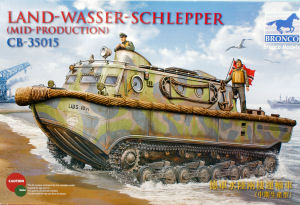
Bronco Models 1/35 Land-Wasser-Schlepper (Mid-Production) Kit First Look
By Michael Benolkin
| Date of Review | July 2008 | Manufacturer | Bronco Models |
|---|---|---|---|
| Subject | Land-Wasser-Schlepper (Mid-Production) | Scale | 1/35 |
| Kit Number | 35015 | Primary Media | Styrene/PE |
| Pros | Nicely detailed kit | Cons | |
| Skill Level | Experienced | MSRP (USD) | $99.98 |
First Look
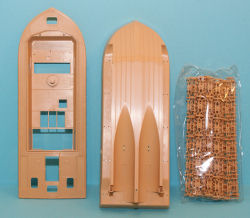 |
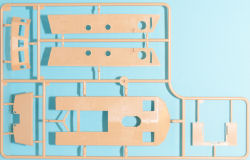 |
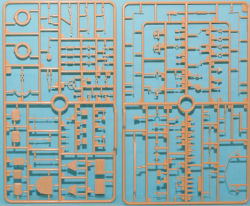 |
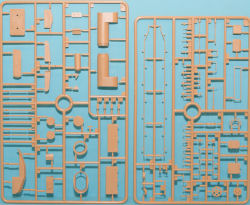 |
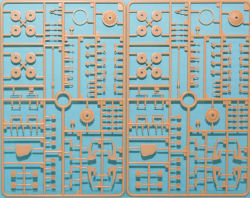 |
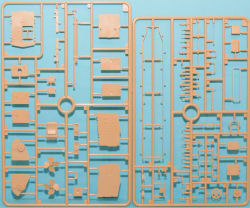 |
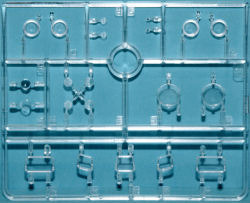 |
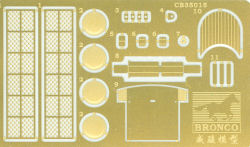 |
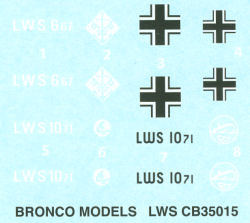 |
 |
The Land-Wasser Schlepper was conceived as an amphibious tug-boat that could pull cargo loaded aboard the LWS and it's cargo trailer out to sea or from ship ashore. On land the LWS was able to move about on unimproved terrain thanks to its tank-like tracks. On water, the LWS was propelled by two large screws, all powered by a Maybach engine.
Rheinmetall produced seven prototypes of this unique vehicle in the late 1930s, but the development program was a low priority until Operation Sea Lion, the invasion of England, became a reality. As production planning was gaining momentum, a number of RAF pilots managed to hold off the might of the Luftwaffe in the Battle of Britain. The loss of German air superiority over England cancelled Operation Sea Lion, and with it, interest in LWS production.
The LWS did see action in the Baltic Sea, but the LWS was not a combat vehicle. The LWS had no protective armor nor any offensive armament. This was about as close to a soft-skinned vehicle that a tracked amphibious boat could be. The LWS had a crew of three and could carry 20 passengers. The trailer could hold 18 tons or the equivalent of an Sd.Kfz.9 half-track.
We've seen some interesting kits coming from Bronco Models over the last few years, but this new kit is somthing completely different. The kit consists of nine trees of tan styrene parts, main deck and hull also molded in tan styrene, one tree of clear parts, and 25 sprues of track links. In addition, one fret of photo-etched parts, one decal sheet, one cloth naval flag, and a length of string for a mooring line round out the kit.
Construction of the model is well laid out in the instructions and appears to be very logical with no challenges that would require three hands and a good sense of timing. In most cases, the instructions clearly show where parts selections must be made. The instructions do indicate a Type A and a Type B LWS, but I've stared at the instructions and can't tell them apart.
Construction begins with assembling the main deck and hull. The Maybach engine, transmission/transfer case, and fuel cells are all below decks out of sight. From here, the road wheels, suspension, and what appear to be track guides are installed on the hull. The drive sprockets, return rollers, and twin screws are installed along with the rudders to complete the hull.
The photo-etched parts provide the engine deck grilles. Also mounted on the aft end are are a pair of pulleys that work with a powered winch installed inside the pilot house.
In addition to the winch, the interior of the pilot house is quite detailed as the this structure extends most of the length of the main deck. Inside there are three crew stations, ducting for the intake stack, and personal weapons storage.
The pilot house has numerous windows and port holes to make the interior visible, though many modelers may opt not to glue this structure in place.
Atop the pilot house, the intake duct extends above structure, numerous radio antennas, spot lights, pioneering tools, and even an anchor are all mounted. Hatches above the crew stations and aft of the intake duct can be positioned open or closed.
Completion of the model comes with the assembly and installation of the track links, installation of the life rings, and a few other additional details.
The instructions offer three marking options. Two are early war examples wearing overall German Gray, whilst the third wears the light gray, blue gray, and light green scheme as depicted on the box art.
Bronco Models has really stepped up their detailing with this kit. A beautifully detailed model can be rendered straight out of the box, while there is still some room for tweaking by the AMS modeler that might want to add the engine, radio gear inside the pilot house, and perhaps some cargo/supplies.
It makes one wonder if we won't see this unique tug boat's barge/trailer in the near future.
This kit is highly recommended!
My sincere thanks to Stevens International for this review sample!







